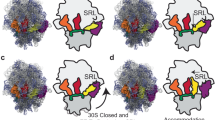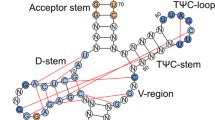Abstract
Aminoacyl-tRNAs (aa-tRNAs) are selected by the ribosome through a kinetically controlled induced fit mechanism. Cognate codon recognition induces a conformational change in the decoding center and a domain closure of the 30S subunit. We studied how these global structural rearrangements are related to tRNA discrimination by using streptomycin to restrict the conformational flexibility of the 30S subunit. The antibiotic stabilized aa-tRNA on the ribosome both with a cognate and with a near-cognate codon in the A site. Streptomycin altered the rates of GTP hydrolysis by elongation factor Tu (EF-Tu) on cognate and near-cognate codons, resulting in almost identical rates of GTP hydrolysis and virtually complete loss of selectivity. These results indicate that movements within the 30S subunit at the streptomycin-binding site are essential for the coupling between base pair recognition and GTP hydrolysis, thus modulating the fidelity of aa-tRNA selection.
This is a preview of subscription content, access via your institution
Access options
Subscribe to this journal
Receive 12 print issues and online access
$189.00 per year
only $15.75 per issue
Buy this article
- Purchase on Springer Link
- Instant access to full article PDF
Prices may be subject to local taxes which are calculated during checkout




Similar content being viewed by others
References
Rodnina, M.V. & Wintermeyer, W. Fidelity of aminoacyl-tRNA selection on the ribosome: kinetic and structural mechanisms. Annu. Rev. Biochem. 70, 415–435 (2001).
Ogle, J.M. et al. Recognition of cognate transfer RNA by the 30S ribosomal subunit. Science 292, 897–902 (2001).
Pape, T., Wintermeyer, W. & Rodnina, M.V. Induced fit in initial selection and proofreading of aminoacyl-tRNA on the ribosome. EMBO J. 18, 3800–3807 (1999).
Pape, T., Wintermeyer, W. & Rodnina, M.V. Conformational switch in the decoding region of 16S rRNA during aminoacyl-tRNA selection on the ribosome. Nat. Struct. Biol. 7, 104–107 (2000).
Ogle, J.M., Murphy, F.V., Tarry, M.J. & Ramakrishnan, V. Selection of tRNA by the ribosome requires a transition from an open to a closed form. Cell 111, 721–732 (2002).
Carter, A.P. et al. Functional insights from the structure of the 30S ribosomal subunit and its interactions with antibiotics. Nature 407, 340–348 (2000).
Ogle, J.M., Carter, A.P. & Ramakrishnan, V. Insights into the decoding mechanism from recent ribosome structures. Trends Biochem. Sci. 28, 259–266 (2003).
Karimi, R. & Ehrenberg, M. Dissociation rate of cognate peptidyl-tRNA from the A-site of hyper-accurate and error-prone ribosomes. Eur. J. Biochem. 226, 355–360 (1994).
Ruusala, T. & Kurland, C.G. Streptomycin preferentially perturbs ribosomal proofreading. Mol. Gen. Genet. 198, 100–104 (1984).
Gromadski, K.B. & Rodnina, M.V. Kinetic determinants of high-fidelity tRNA discrimination on the ribosome. Mol. Cell 13, 191–200 (2004).
Rodnina, M.V., Pape, T., Fricke, R., Kuhn, L. & Wintermeyer, W. Initial binding of the elongation factor Tu–GTP–aminoacyl-tRNA complex preceding codon recognition on the ribosome. J. Biol. Chem. 271, 646–652 (1996).
Pape, T., Wintermeyer, W. & Rodnina, M.V. Complete kinetic mechanism of elongation factor Tu-dependent binding of aminoacyl-tRNA to the A site of the E. coli ribosome. EMBO J. 17, 7490–7497 (1998).
Daviter, T., Wieden, H.-J. & Rodnina, M.V. Essential role of histidine 84 in elongation factor Tu for the chemical step of GTP hydrolysis on the ribosome. J. Mol. Biol. 332, 689–699 (2003).
Rodnina, M.V., Fricke, R., Kuhn, L. & Wintermeyer, W. Codon-dependent conformational change of elongation factor Tu preceding GTP hydrolysis on the ribosome. EMBO J. 14, 2613–2619 (1995).
Thompson, R.C., Dix, D.B., Gerson, R.B. & Karim, A.M. Effect of Mg2+ concentration, polyamines, streptomycin, and mutations in ribosomal proteins on the accuracy of the two-step selection of aminoacyl-tRNAs in protein biosynthesis. J. Biol. Chem. 256, 6676–6681 (1981).
Lando, D., Cousin, M.A., Ojasoo, T. & Raymond, J.P. Paromomycin and dihydrostreptomycin binding to Escherichia coli ribosomes. Eur. J. Biochem. 66, 597–606 (1976).
Bilgin, N. & Ehrenberg, M. Mutations in 23 S ribosomal RNA perturb transfer RNA selection and can lead to streptomycin dependence. J. Mol. Biol. 235, 813–824 (1994).
Grise-Miron, L., Noreau, J., Melancon, P. & Brakier-Gingras, L. Comparison of the misreading induced by streptomycin and neomycin. Biochim. Biophys. Acta 656, 103–110 (1981).
Yates, J.L. Role of ribosomal protein S12 in discrimination of aminoacyl-tRNA. J. Biol. Chem. 254, 11550–11554 (1979).
Campuzano, S., Cabanas, M.J. & Modolell, J. The binding of non-cognate Tyr-tRNATyr to poly(uridylic acid)-programmed Escherichia coli ribosomes. Eur. J. Biochem. 100, 133–139 (1979).
Fersht, A. Structure and Mechanism in Protein Science 630 (Freeman, New York, 1998).
Ehrenberg, M., Bilgin, N. & Kurland, C.G. Design and use of a fast and accurate in vitro translation system. In Ribosomes and Protein Biosynthesis. The Practical Approach Series (ed. Spedding, G.) 101–129 (IRL, Oxford, 1990).
Thompson, R.C. & Stone, P.J. Proofreading of the codon-anticodon interaction on ribosomes. Proc. Natl. Acad. Sci. USA 74, 198–202 (1977).
Belanger, F., Leger, M., Saraiya, A.A., Cunningham, P.R. & Brakier-Gingras, L. Functional studies of the 900 tetraloop capping helix 27 of 16S ribosomal RNA. J. Mol. Biol. 320, 979–989 (2002).
O'Connor, M., Thomas, C.L., Zimmermann, R.A. & Dahlberg, A.E. Decoding fidelity at the ribosomal A and P sites: influence of mutations in three different regions of the decoding domain in 16S rRNA. Nucleic Acids Res. 25, 1185–1193 (1997).
Gregory, S.T., Bayfield, M.A., O'Connor, M., Thompson, J. & Dahlberg, A.E. Probing ribosome structure and function by mutagenesis. Cold Spring Harb. Symp. Quant. Biol. 66, 101–108 (2001).
Gregory, S.T., Cate, J.H. & Dahlberg, A.E. Streptomycin-resistant and streptomycin-dependent mutants of the extreme thermophile Thermus thermophilus. J. Mol. Biol. 309, 333–338 (2001).
Robert, F. & Brakier-Gingras, L. A functional interaction between ribosomal proteins S7 and S11 within the bacterial ribosome. J. Biol. Chem. 278, 44913–44920 (2003).
Vila-Sanjurjo, A. et al. X-ray crystal structures of the WT and a hyper-accurate ribosome from Escherichia coli. Proc. Natl. Acad. Sci. USA 100, 8682–8687 (2003).
Stark, H. et al. Ribosome interactions of aminoacyl-tRNA and elongation factor Tu in the codon recognition complex. Nat. Struct. Biol. 9, 849–854 (2002).
Valle, M. et al. Cryo-EM reveals an active role for aminoacyl-tRNA in the accommodation process. EMBO J. 21, 3557–3567 (2002).
Valle, M. et al. Incorporation of aminoacyl-tRNA into the ribosome as seen by cryo-electron microscopy. Nat. Struct. Biol. 10, 899–906 (2003).
Vorstenbosch, E., Pape, T., Rodnina, M.V., Kraal, B. & Wintermeyer, W. The G222D mutation in elongation factor Tu inhibits the codon-induced conformational changes leading to GTPase activation on the ribosome. EMBO J. 15, 6766–6774 (1996).
Yarus, M., Valle, M. & Frank, J. A twisted tRNA intermediate sets the threshold for decoding. RNA 9, 384–385 (2003).
Yarus, M. & Smith, D. tRNA on the ribosome: a waggle theory. In tRNA: Structure, Biosynthesis, and Function (ed. RajBhandary, U.) 443–468 (American Society for Microbiology, Washington, DC, 1995).
Rodnina, M.V., Fricke, R. & Wintermeyer, W. Transient conformational states of aminoacyl-tRNA during ribosome binding catalyzed by elongation factor Tu. Biochemistry 33, 12267–12275 (1994).
Piepenburg, O. et al. Intact aminoacyl-tRNA is required to trigger GTP hydrolysis by elongation factor Tu on the ribosome. Biochemistry 39, 1734–1738 (2000).
Vogeley, L., Palm, G.J., Mesters, J.R. & Hilgenfeld, R. Conformational change of elongation factor Tu (EF-Tu) induced by antibiotic binding. Crystal structure of the complex between EF-Tu–GDP and aurodox. J. Biol. Chem. 276, 17149–17155 (2001).
Mohr, D., Wintermeyer, W. & Rodnina, M.V. GTPase activation of elongation factors Tu and G on the ribosome. Biochemistry 41, 12520–12528 (2002).
Vetter, I.R. & Wittinghofer, A. The guanine nucleotide-binding switch in three dimensions. Science 294, 1299–1304 (2001).
Gromadski, K.B., Wieden, H.J. & Rodnina, M.V. Kinetic mechanism of elongation factor Ts-catalyzed nucleotide exchange in elongation factor Tu. Biochemistry 41, 162–169 (2002).
Calogero, R.A., Pon, C.L., Canonaco, M.A. & Gualerzi, C.O. Selection of the mRNA translation initiation region by Escherichia coli ribosomes. Proc. Natl. Acad. Sci. USA 85, 6427–6431 (1988).
Rodnina, M.V. & Wintermeyer, W. GTP consumption of elongation factor Tu during translation of heteropolymeric mRNAs. Proc. Natl. Acad. Sci. USA 92, 1945–1949 (1995).
Katunin, V.I., Muth, G.W., Strobel, S.A., Wintermeyer, W. & Rodnina, M.V. Important contribution to catalysis of peptide bond formation by a single ionizing group within the ribosome. Mol. Cell 10, 339–346 (2002).
Stern, S., Moazed, D. & Noller, H.F. Structural analysis of RNA using chemical and enzymatic probing monitored by primer extension. Methods Enzymol. 164, 481–489 (1988).
Moazed, D. & Noller, H.F. Interaction of antibiotics with functional sites in 16S ribosomal RNA. Nature 327, 389–394 (1987).
Acknowledgements
We thank W. Wintermeyer for critical reading and discussions and V. Ramakrishnan for valuable comments on the manuscript. We thank A. Kubarenko for doing the footprinting experiment, V. Katunin and Y. Semenkov for tRNA preparations, U. Kothe for donating EF-Tu H84A, P. Striebeck, A. Böhm, C. Schillings and S. Möbitz for expert technical assistance. The work was supported by the Deutsche Forschungsgemeinschaft, the Alfried Krupp von Bohlen und Halbach-Stiftung and the Fonds der Chemischen Industrie.
Author information
Authors and Affiliations
Corresponding author
Ethics declarations
Competing interests
The authors declare no competing financial interests.
Rights and permissions
About this article
Cite this article
Gromadski, K., Rodnina, M. Streptomycin interferes with conformational coupling between codon recognition and GTPase activation on the ribosome. Nat Struct Mol Biol 11, 316–322 (2004). https://doi.org/10.1038/nsmb742
Received:
Accepted:
Published:
Issue Date:
DOI: https://doi.org/10.1038/nsmb742
This article is cited by
-
Translation error clusters induced by aminoglycoside antibiotics
Nature Communications (2021)
-
Reduced Protein Synthesis Fidelity Inhibits Flagellar Biosynthesis and Motility
Scientific Reports (2016)
-
A structural basis for streptomycin-induced misreading of the genetic code
Nature Communications (2013)
-
Optimization of speed and accuracy of decoding in translation
The EMBO Journal (2010)
-
Mutational analysis reveals two independent molecular requirements during transfer RNA selection on the ribosome
Nature Structural & Molecular Biology (2007)



